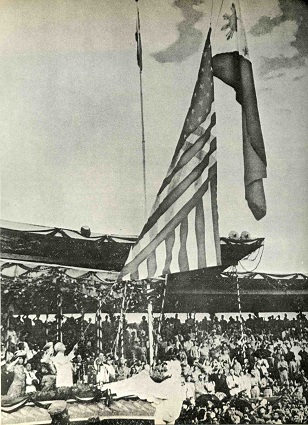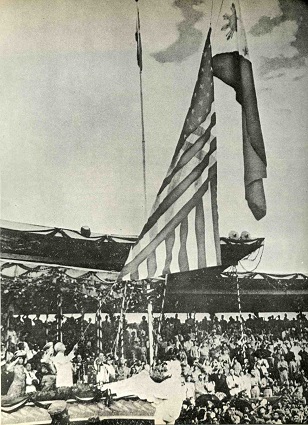 via Philippine Presidential Museum and Library/a>)” width=”308″ height=”425″ />The flag of the United States is lowered while the flag of the Philippines is raised during the Independence Day ceremonies on July 4, 1946. (Photo via Philippine Presidential Museum and Library)This week marks the 80th anniversary of the passage of the Tydings-McDuffie Act, which established conditions for the United States to grant the Philippines its independence after nearly five decades of American rule. The circumstances surrounding the passage of this historic legislation serve as a reminder of our nation’s lamentable experiment with overseas empire-building and a reckoning with this imperial past help us to understand one of the most visible legacies of this complicated relationship, the large number of Filipinos currently living in the United States.
via Philippine Presidential Museum and Library/a>)” width=”308″ height=”425″ />The flag of the United States is lowered while the flag of the Philippines is raised during the Independence Day ceremonies on July 4, 1946. (Photo via Philippine Presidential Museum and Library)This week marks the 80th anniversary of the passage of the Tydings-McDuffie Act, which established conditions for the United States to grant the Philippines its independence after nearly five decades of American rule. The circumstances surrounding the passage of this historic legislation serve as a reminder of our nation’s lamentable experiment with overseas empire-building and a reckoning with this imperial past help us to understand one of the most visible legacies of this complicated relationship, the large number of Filipinos currently living in the United States.
The act often was hailed as evidence of the benevolent character of the American imperial project, which was motivated by the desire to “uplift and civilize” the native population who had suffered under more than three centuries of Spanish domination. The US annexed the Philippines in 1899 in the aftermath of the Spanish-American War, despite objections from Filipino leaders who already had formed an independent government. American statesmen, however, declared Filipinos unfit for self-rule. Only after a protracted period of intensive colonial tutelage would Filipinos be allowed to run their own affairs. Adding insult to injury, American officials argued (without irony) that the US was duty-bound to take possession of the islands to protect them from the nefarious designs of self-serving foreign powers.
The eventual withdrawal of US sovereignty over the Philippines was far from a foregone conclusion that vindicated the American way of empire, and the origins of the Tydings-McDuffie Act offer a far more complex story involving racial animus, economic competition and the entanglement of domestic and foreign policy objectives.
Filipinos, as American colonial subjects, were exempted from restrictive laws that barred immigration from Asia countries. The exponential growth of the agribusiness sector in Hawaii and the West Coast during the early 20th century spurred a large demand for cheap, flexible labor. Agribusiness concerns actively recruited Filipinos to do field and cannery work previously carried out by Chinese and Japanese immigrants.
Filipino immigration to the United States during the early decades of the 20th century generated significant controversy, especially on the West Coast, where their arrival was characterized as the “third Asiatic invasion” (following on the heels of the Chinese and Japanese “invasions”). Following the popular cultural script of the period, the newcomers were accused of stealing jobs from white citizens, spreading disease and displaying a propensity for criminality. The fact that the first wave of Filipino immigrants was made up overwhelmingly of young male laborers without traditional family moorings was viewed as a budding social problem.
Beginning in the late 1920s, the powerful West Coast nativist lobby pressed federal officials to enact legislation barring the entry of Filipinos. These efforts failed to make headway in Congress, with many lawmakers expressing concern about the diplomatic fallout that might result from excluding Filipino immigrants while they lived under the American flag. Key Congressional leaders worried that such a course of action would violate international norms followed by other imperial powers allowing colonial subjects unimpeded access to the “mother country.”
The failure of the federal government to take action compelled nativist leaders to ratchet up their campaign, hoping to galvanize greater public support for exclusion. Alarmist rhetoric accusing Filipino immigrants of brazenly defying the color line by pursuing social relationships with white women attracted significant media attention. Filipinos, moreover, were charged with exhibiting a penchant for labor militancy that threatened to upend the traditional balance of power between agribusiness and immigrant workers.
Moral panics about interracial sex and political subversion soon spurred public action most visibly manifested in a series of race riots and vigilante campaigns targeting Filipino immigrants on the West Coast in the late 1920s and early 1930s. Violence and acrimony directed at the “invaders” attracted national media attention and eventually prompted Congress to hold hearings on the “Filipino problem.” The nativist lobby used the platform to press its case for exclusion, soliciting support from Southern Congressional representatives, drawing comparisons between Filipino and African-American men’s alleged ardor for white women. Legislation aimed at restricting Filipino immigration stalled again, with the Philippines status as a US possession remaining the chief sticking point.
Nativist leaders quickly adopted a new strategy, embracing the cause of Philippine independence in the early 1930s. Once the Philippines was granted its sovereignty, they reasoned, Filipinos would no longer be exempt from restrictive immigration quotas. While there had long been a vocal base of support in Congress for Philippine independence, it was opposed by powerful constituencies in the federal government who viewed the archipelago as a valuable geo-strategic asset.
The nativist lobby entered into a makeshift coalition with two other important groups pushing for independence. The first was Midwestern agricultural interests, concerned about the importation of inexpensive Philippine products that entered the US duty-free because of the colonial status of the islands. Domestic sugar beet growers feared competition from cheap Philippine cane sugar, and dairy farmers saw coconut oil (formerly a key ingredient in margarine) as hurting the demand for butter. Their political agenda ran parallel to that of the nativists, except they advocated independence as a way to restrict the free entry of Philippine goods, rather than Filipino labor.
Filipino nationalists made up another segment of the independence coalition. Their demands for self-determination pre-dated the Spanish-American War, and indignity surrounding racist treatment and violence against Filipinos living in the US gave their campaign a renewed urgency. While Filipino leaders recognized that they their political allies had less-than-noble intentions, they believed that a Faustian pact was the price to pay for freedom.
The Tydings-McDuffie Act was signed into law in March 1934, despite opposition from the State Department and War Department. The act bore the hallmarks of the various interest groups involved in its passage. In a nod to the opposition, the Philippines would have to complete a 10-year probationary period before the US would formally relinquish its sovereignty over the islands. The status of Filipinos remained largely unchanged during this so-called “Commonwealth” period. They continued to “owe allegiance” to the United States while the Philippines remained under US administrative jurisdiction.
Although independence was delayed for 10 years, two key sections of the act went into effect immediately. Tariffs targeting Philippine sugar, coconut oil and other products were implemented quickly – a clear victory for Midwestern agribusiness interests. In addition, Filipinos immediately were subject to restrictive immigration laws barring the admission of other Asian groups. The Philippines was granted a token quota of 50 immigrants per year, the lowest number allotted to any country in the world. Nativist leaders were quick to take credit for the harsh new quota, believing that it reflected the prevailing racial animus towards Filipinos in the United States.
The unsavory political forces that helped push the Tydings-McDuffie Act through Congress were not lost on Filipino leaders, who observed that the act was as much about the “independence of America from the Philippines” as it was about independence for the Philippines. Filipinos living in the United States faced an uncertain future and remained a feature of everyday life, a fact evidenced by the passage of the Filipino Repatriation Act in 1935, which aimed to “relocate” resident Filipinos back to their homeland.
The Philippines’ march to independence was thrown into peril halfway through its 10-year probation, when Japan attacked the Philippines on December 8, 1941. Interestingly, a little-known provision of the Tydings-McDuffie Act empowered the president of the United States to conscript all Philippine military personnel into the US armed forces. President Roosevelt did just that and approximately 200,000 Filipinos eventually would serve under US military command during World War II.
The Allied war victory ensured that Philippine independence was put back on track and the war-torn country finally was granted its sovereignty on July 4, 1946. The date was a conscious choice made by US officials that would serve as a permanent reminder of America’s lasting influence over the islands. The large and growing Filipino population currently residing in the United States is one enduring consequence of that influence. Filipinos have long been coveted by American employers because of their English language skills and familiarity with US culture. These traits, of course, are the inheritance of empire and a reminder that Filipinos came to the United States only after Americans came to the Philippines.
Help us Prepare for Trump’s Day One
Trump is busy getting ready for Day One of his presidency – but so is Truthout.
Trump has made it no secret that he is planning a demolition-style attack on both specific communities and democracy as a whole, beginning on his first day in office. With over 25 executive orders and directives queued up for January 20, he’s promised to “launch the largest deportation program in American history,” roll back anti-discrimination protections for transgender students, and implement a “drill, drill, drill” approach to ramp up oil and gas extraction.
Organizations like Truthout are also being threatened by legislation like HR 9495, the “nonprofit killer bill” that would allow the Treasury Secretary to declare any nonprofit a “terrorist-supporting organization” and strip its tax-exempt status without due process. Progressive media like Truthout that has courageously focused on reporting on Israel’s genocide in Gaza are in the bill’s crosshairs.
As journalists, we have a responsibility to look at hard realities and communicate them to you. We hope that you, like us, can use this information to prepare for what’s to come.
And if you feel uncertain about what to do in the face of a second Trump administration, we invite you to be an indispensable part of Truthout’s preparations.
In addition to covering the widespread onslaught of draconian policy, we’re shoring up our resources for what might come next for progressive media: bad-faith lawsuits from far-right ghouls, legislation that seeks to strip us of our ability to receive tax-deductible donations, and further throttling of our reach on social media platforms owned by Trump’s sycophants.
We’re preparing right now for Trump’s Day One: building a brave coalition of movement media; reaching out to the activists, academics, and thinkers we trust to shine a light on the inner workings of authoritarianism; and planning to use journalism as a tool to equip movements to protect the people, lands, and principles most vulnerable to Trump’s destruction.
We’re asking all of our readers to start a monthly donation or make a one-time donation – as a commitment to stand with us on day one of Trump’s presidency, and every day after that, as we produce journalism that combats authoritarianism, censorship, injustice, and misinformation. You’re an essential part of our future – please join the movement by making a tax-deductible donation today.
If you have the means to make a substantial gift, please dig deep during this critical time!
With gratitude and resolve,
Maya, Negin, Saima, and Ziggy
